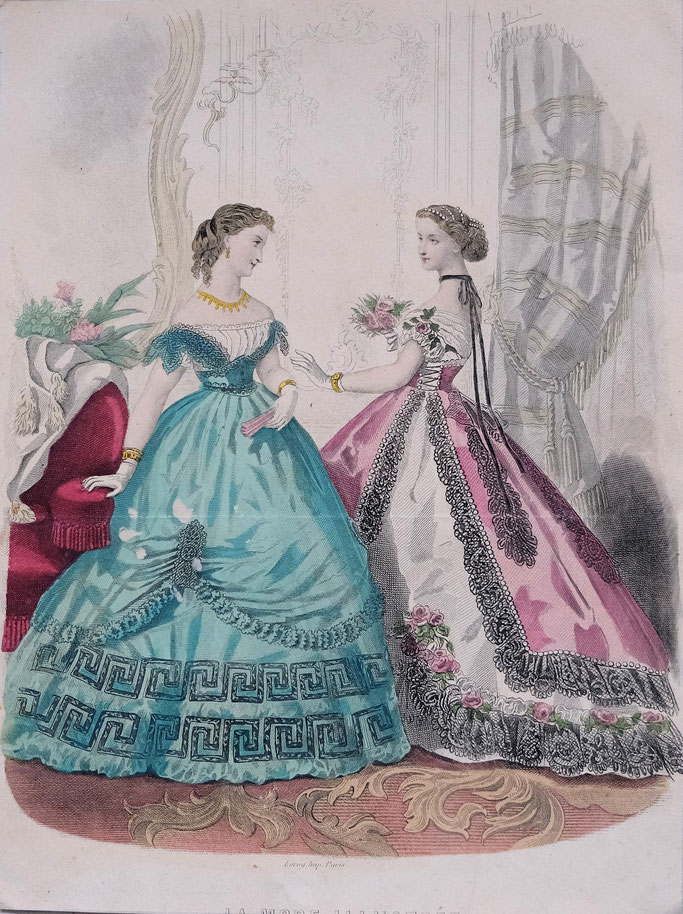
Magazine Owner Emmeline Raymond and Her Illustrators Héloïse and Adele-Anaïs Colin
La Mode Illustrée, subtitled Journal de la Famille, was a French fashion magazine published between 1860 and 1937. Its founder, Emmeline Raymond, was a pioneering women in the male-dominated world of 19th-century publishing and also hired female artists and lithographers. La Mode Illustrée grew to be one of the biggest fashion magazines in the world during the second half of the 19th century.
Emmeline Raymond lived from 1828 until 1902. Though little is documented about her early life, her work on La Mode Illustrée which stands as a testament to her determination and
editorial skill. With La Mode
Illustrée, Emmeline Raymond placed herself into a longer tradition of fashion magazines and she successfully adapted the format to her own
era. The early 1800s had seen a whole flurry of circulating fashion magazines, from Costume Parisien to Ackermann’s Repository of Arts. La Mode Illustrée encouraged women to engage with culture and fashion actively. Raymond
filled her magazine to the brim with knitting and embroidery patterns, fashion plates and descriptions, reports from cultural and society events, poetry and edifying texts to entertain and
instruct. Her magazine’s influence reached far beyond France, cementing Paris as the
heart of fashion and inspiring women to embrace style, skill, and sophistication. With its focus on aesthetics and practical instructions, La Mode Illustrée attracted a diverse readership and enabled the subscribers to create fashion and decorative items themselves.
The Sisterhood and Artistry Behind the Magazine
While Raymond’s leadership gave the magazine its foundation and voice, La Mode Illustrée’s visual appeal – already highlighted in the magazine’s name – was shaped largely by female artists and sisters Héloïse Colin (1819–1873) and Adele-Anaïs Toudouze (1822–1899). Each edition included lithography prints of the latest styles, often showing outfits in various social settings such as morning dresses set in nature or opulent ball gowns in interiors. Through the visuals, readers could imagine the flow and feel of the dresses and to imagine themselves in the garments.
The technique of lithography is based on the principle that oil and water repel each other. To create a lithograph, the Colin sisters would draw an image directly onto a flat, smooth limestone or
metal plate using a greasy substance. The plate was then treated with a chemical solution which made the untouched areas of the plate more hydrophilic. The plate was then moistened and the blank
areas would attract and absorb the water. When then applying a special oily ink, it would only stick to the greasy drawing lines and not the moistened areas where the water repelled it. Paper was
then pressed onto the stone to print the illustration by transferring the ink onto the paper. This technique allowed for fine lines and a hardwearing printing block able to produce many prints,
making lithographs an excellent choice for fashion illustrations.
The Colin sisters grew up in an artistic family descended from Jean-Baptise Greuze. Their father, painter Alexandre Colin, educated his daughters at home and early on nurtured their passion and
talent for art in his home studio fittingly named Père (father). Their mother seems to have died young as her father at some point re-married
and had at least two more children. Alexandre Colin was part of the Romantic movement and moved in circles of renowned artists such as
Eugène Delacroix and Théodore Gericault. This enabled the daughters to be in close contact with the art world of their time, to learn and observe and also to network. In 1835, Héloïse exhibited at the Salon and the sisters each won awards and publicity for their art when still teenagers. Héloïse went on to marry painter
Adolphe Rouargue. She maintained her artistry and became particularly focused on illustration and lithography. Thus she worked for La Mode
Illustrée and also produced watercolours, book illustrations and miniature portraits.
Adele-Anaïs married architect and engraver Gabriel Toudouze in 1845 and had three children with him. When he died young, her artistic work and professional track-record enabled her to financially provide for her family herself.
The Colin sisters often also worked together on projects. Their illustrations were essential for those who wanted to remain informed at all times about the latest Parisian styles and they were invaluable for those who wanted to take the magazine to their local dressmakers and get garments inspired by the magazine sheets tailored for themselves.

